Configuring IGEL Azure Virtual Desktop client
Configuring the Logon
In the profile configurator, go to Apps > AVD > AVD Sessions > [session name] > Logon.
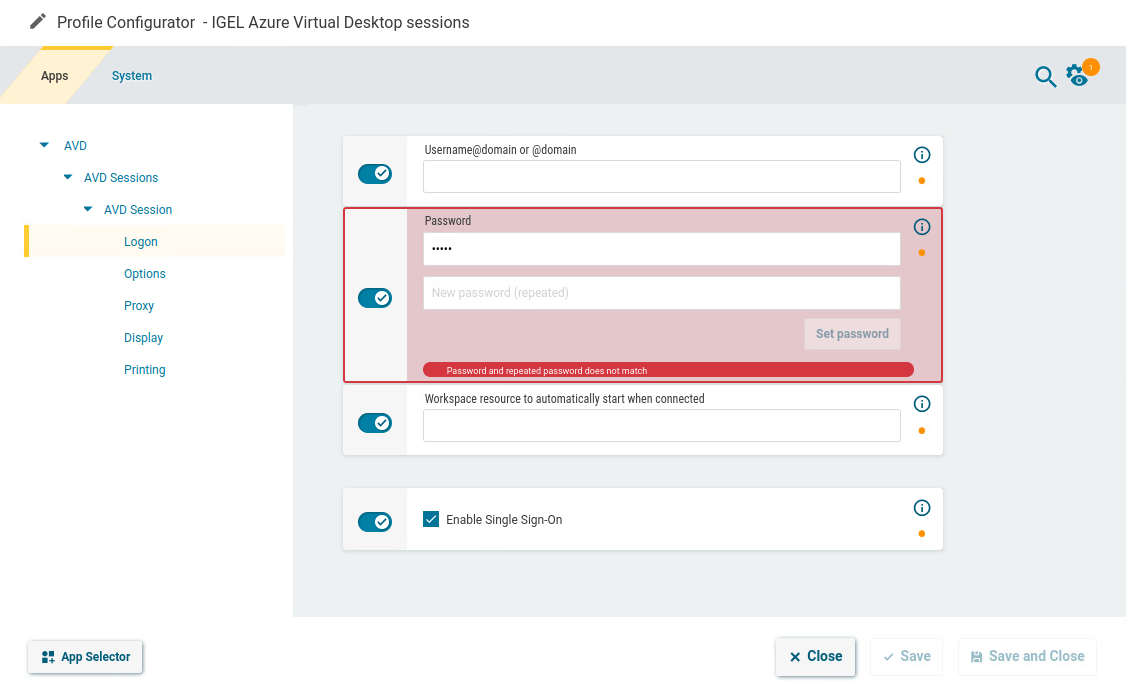
Edit the settings according to your needs. The parameters are described in the following.
Username@domain or @domain
The user name or a preset domain name that will be used for the automatic connection to the AVD session. The string after "@" is taken as a preset domain name.
Example:
avd@your.domain.com: To log in, the user does not need to enter the username and the domain name.
@your.domain.com: To log in, the user only needs to enter the username, e.g. avd. The preset domain – your.domain.com – will automatically be appended.
Overwriting the Preset Domain Name
Use the following registry key to specify whether the user should be able to overwrite the preset domain, e.g. with username@other-domain.com:
Path | System > Registry |
Parameter | Allow preset domain overwrite |
Registry |
|
Value | enabled / disabled |
Note | If enabled: the domain entered by the user is accepted. |
Password
This password is used for the automatic connection to the AVD session.
If the Login Credentials Should Not Be Applied Automatically
You can use the following registry key to always prompt for a username and password or only for a password when connecting to an AVD session:
Path | System > Registry |
Parameter | Always prompt for username and password upon session host connection |
Registry |
|
Value | enabled / disabled |
Path | System > Registry |
Parameter | Always prompt for password upon session host connection |
Registry |
|
Value | enabled / disabled |
Note | On the server side, you can enable the RDP group policy "Always prompt for password upon connection" to achieve the same result. |
Workspace resource to automatically start when connected
Name of the published app or desktop session that is to be started automatically.
Enable Single Sign-On
- Single sign-on (SSO) is activated. (Default)
Editing the Options
In the profile configurator, go to Apps > AVD > AVD Sessions > [session name] > Options.
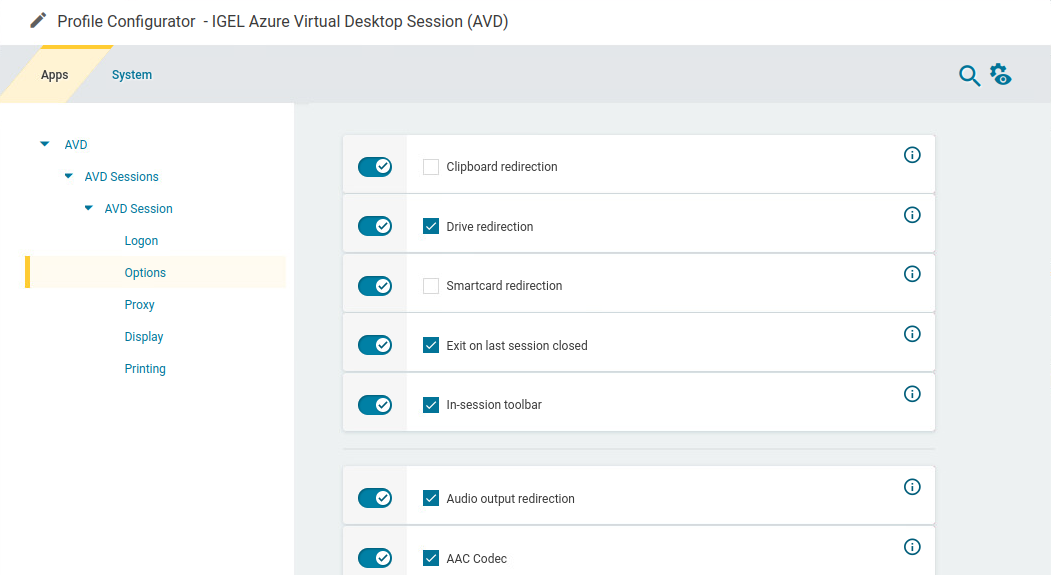
Edit the settings according to your needs. The parameters are described in the following.
Clipboard redirection
- Text and images from the clipboard are shared between the AVD session and the local client.
- No sharing of text and images. (Default)
Drive redirection
- Redirection is bound to the
/mediafolder, so that locally mounted storage devices, including USB sticks, are forwarded to the AVD session. (Default)
Smartcard redirection
- Smartcards are forwarded to the AVD session.
- No smartcard redirection. (Default)
Exit on last session closed
- When the last session window is closed, the entire IGEL AVD Client automatically closes. (Default)
In-session toolbar
- The in-session toolbar is enabled. (Default)
Audio output redirection
- The audio output is redirected between the AVD session and the local client. (Default)
AAC codec
- The AAC (Advanced Audio Coding) codec used for support of audio output redirection is enabled. (Default)
Audio input redirection
- The audio input (microphone) is redirected between the local client and the AVD session. (Default)
Configuring a Proxy
In the profile configurator, go to Apps > AVD > AVD Sessions > [session name] > Proxy.
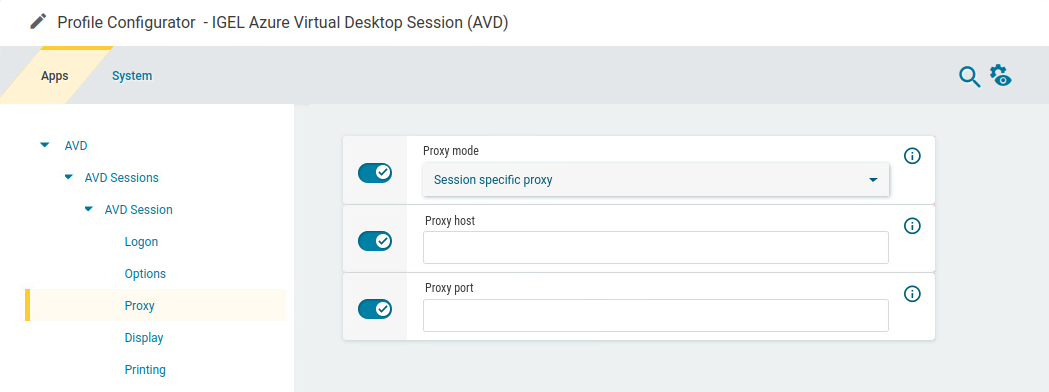
Edit the settings according to your needs. The parameters are described in the following.
Proxy Configuration via a PAC File
If you want to use a PAC file, set Proxy mode to "Global proxy setting" and specify the URL of the PAC file under Network > Proxy > System-wide proxy configuration > Automatic proxy configuration.
Proxy mode
Specifies if a proxy should be used.
Possible options:
Off: The use of a proxy is disabled. A direct connection to the Internet is used. (Default)
Global proxy setting: The proxy configured under Network > Proxy is used.
Session specific proxy: The proxy configuration specified under Proxy host and Proxy port is used.
The following fields are active if Proxy mode is set to Session specific proxy:
Proxy host
Hostname or IP address of the proxy server
Proxy port
Port on which the proxy service is available
Configuring the Display
In the profile configurator, go to Apps > AVD > AVD Sessions > [session name] > Display.
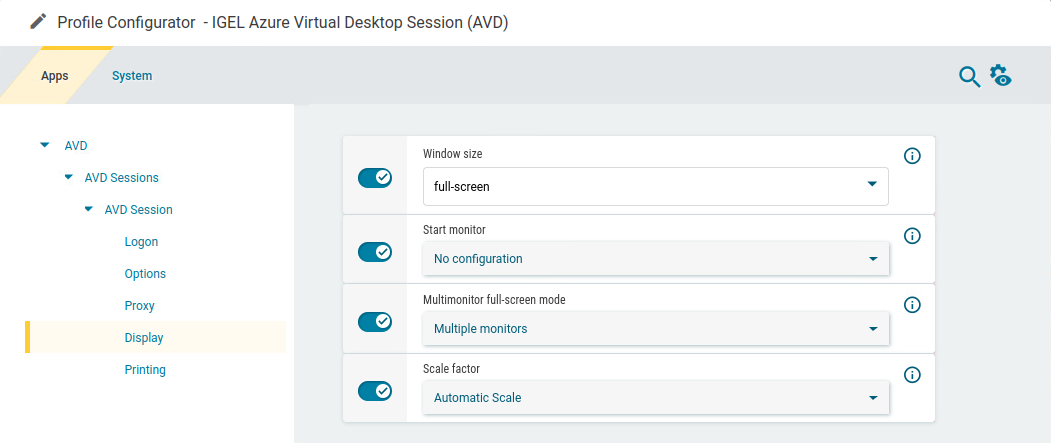
Edit the settings according to your needs. The parameters are described in the following.
Window size
Specifies the width and height of the window.
Possible options:
Full-screen: The session is shown on the full screen. The device's taskbar is not visible. (Default)
Work area: The session is shown on the full screen, minus the area needed by the device's taskbar.
Numeric details: The session is shown in the selected resolution or on the selected percentage of the screen area.
Start monitor
Specifies the monitor on which the session is displayed.
Possible options:
No configuration: The monitor is selected according to the current position of the mouse pointer.
1st monitor ... 8th monitor: The selected monitor is the start monitor.
Multimonitor full-screen mode
This setting is relevant if more than one monitor is connected to the terminal.
Possible options:
Global setting: Currently the same as Multiple monitors.
Single monitor: Restricts the full-screen session to one monitor.
Multiple monitors: Displays the full-screen session on multiple monitors. (Default)
Expand to all monitors: Expands the full-screen session across all monitors.
Scale factor
Specifies the desktop scaling in percent.
Possible values:
Automatic scale: The resolution set under User Interface > Display > Options > Monitor DPI is used for the session. (Default)
Numeric details: The display is magnified by the factor given here.
Configuring Printing
In the profile configurator, go to Apps > AVD > AVD Sessions > [session name] > Printing.
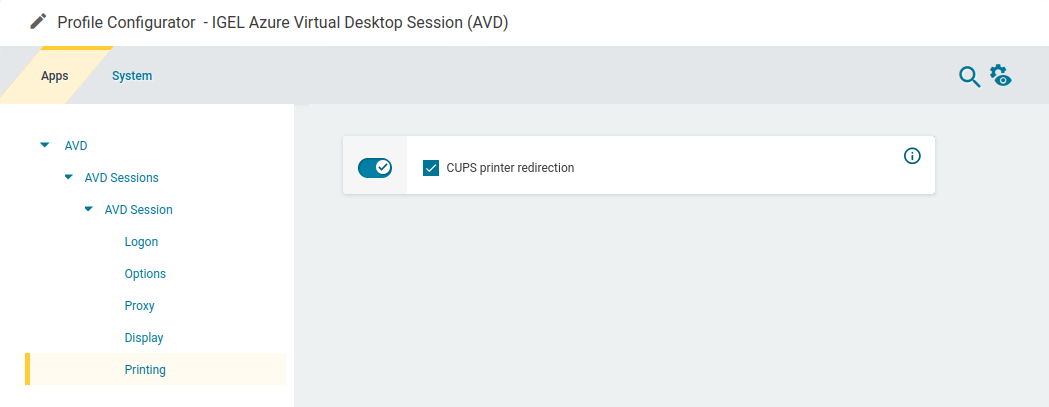
Edit the settings according to your needs. The parameters are described in the following.
CUPS printer redirection
- CUPS printers are redirected to the AVD session from the local endpoint. CUPS printers are configured under CUPS Printing > Printer and must be mapped into the AVD session under Map printer in AVD sessions. (Default)
Set the printer driver name under System > Registry > app > cups_printing > print > cups > printer% > avd_printer_driver:
The default Windows driver name is "Microsoft PS Class Driver"; it is usually installed by default and works generically.
In the case of a custom printer driver, make sure the driver is installed on the AVD server side and enter the exact name of the driver.
